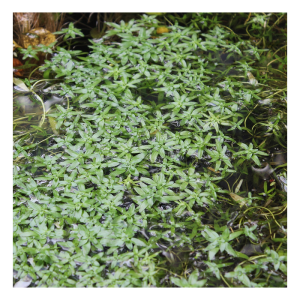Starry Rose
Home " Oxygen plants " Starry Rose
Star rose. Fun for both above and below the water!
Are you looking for a nice water plant for your pond that produces oxygen and shades the water? Then this aquatic plant is definitely a good choice. It is not to be confused with the pesky duckweed! The underwater leaves add essential oxygen to your pond, while the floating leaves provide shade. This gives Starweed a double function in terms of algae control. This oxygen plant also grows quickly. During this growth, many nutrients are absorbed from the water.
Since algae use the same nutrients to grow, the algae have a strong competitor. In addition, the duckweed cover reduces the amount of sunlight entering the water. Algae need sunlight to grow. By blocking sunlight, Starweed reduces algae growth and keeps your pond clearer!
This oxygen plant occurs naturally in the Netherlands, in both still and flowing water. It rarely blooms in the Netherlands and since the flowers are green, it is not really noticeable when in bloom. For the flowering species, please refer to Water Ranunculus and Water Violier.
Stargazer Properties
- Placement: Sun.
- Planting depth: 40 to 80 cm.
- Stems grow up to about 80 cm long.
- Substrate: Necessary, rooting aquatic plant.
- Low lime water finds this oxygen plant pleasant.
Frequently asked questions
How many oxygen plants should be in my pond?
The standard rule of thumb for oxygen plants applies to this aquatic plant. 4 to 5 bunches per 1,000 litres of water ensures the best results in terms of clarity, oxygen production and algae prevention. You can, of course, combine a number of different species.
What is the flowering period of Star Cress?
Stargazer (Callitriche) blooms from May to August. Flowering is quite inconspicuous, with small, greenish flowers that often remain submerged. The flowers are not the most distinctive aspect of the plant, but they do play a role in reproduction. The plant also forms many new shoots through vegetative growth, which ensures rapid spread.
Is Stargazer a native aquatic plant?
Yes, starwort is a native aquatic plant in the Netherlands and is common in European waters. It thrives in ditches, ponds, marshes and slow-flowing waters. Starweed plays an important role in the ecology of wetlands by adding oxygen to the water and providing shelter for small aquatic animals.
How to plant Star Crocus?
Star spider moss is easily planted by placing the plant in the water without anchoring it in the ground. The plant spreads quickly via the stems and forms dense mats that float on or just below the water surface. You can place the plant in both still and slow-flowing water, where it will expand naturally.
How do I maintain Star Crocus?
Starwort requires little maintenance, but because it grows quickly, it can quickly take over ponds and water features. Regular thinning or removal of excess plants is important to prevent it from overgrowing other aquatic plants. The plant is useful for improving water quality, but it is important to maintain a balance.
Is Star Crocus hardy?
Yes, Star Crocus is hardy and can withstand cold winters well. In winter, growth slows down, but the plant remains active under ice or in cold water. In spring, growth starts again more rapidly as soon as the temperature rises, and the plant will quickly develop new shoots.
What is the planting depth of Star Crocus?
Starwort can grow in shallow water to a depth of about 50 cm. The plant usually floats on the water surface or just below it, but needs sufficient light for photosynthesis. Starwort thrives in clear water and can grow in both still and slow-flowing water, as long as the depth is not too great to limit light penetration.
Buying starburst?

We have had good experiences with oxygen plants from De Vijvermeester. Featherweed is for sale via De Vijvermeester's webshop. Here you can find beautiful bunches of high quality.
